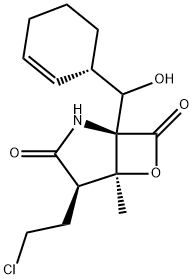Marizomib has been used as a proteasome inhibitor:
- to study its effects on glioblastoma cell lines
- to analyze its effects on the aging of killifish brain
- to test its effect on protein kinase B (PKB/AKT) levels in multiple myeloma cells
ChEBI: A salinosporamide in which the core (1R)-6-oxa-2-azabicyclo[3.2.0]heptane-3,7-dione skeleton is substituted at positions 1, 4, and 5 by (1S)-cyclohex-2-en-1-yl(hydroxy)methyl, 2-chloroethyl, and methyl groups, respectively
(the 1R,4R,5S diastereoisomer). A potent proteasome inhibitor, it has attracted interest for potential use in the treatment of various cancers.
salinosporamide a is a potent inhibitor of 20s proteasome with ic50 value of 1.3 nm [1].salinosporamide a was isolated from the crude extract of a salinospora strain cnb-392. it showed potent anti-tumor activity with an ic50 value of 11 ng/ml in hct-116 cells. it also exerted a mean gi50 value of less than 10 nm in the nci’s 60 cell line-panel. among these cell lines, salinosporamide a showed the greatest potent efficacies in nci-h226, sf-539, sk-mel-28 and mda-mb-435 cells. salinosporamide a inhibited the purified 20s proteasome with ic50 value of 1.3 nm. it was about 35-fold more potent than the first discovered specific proteasome inhibitor, omuralide [1].
Marizomib is a second generation proteasome inhibitor with anti-cancer activity. Marizomib binds irreversibly and potently inhibits all three 20S proteasome subunits.
[1] feling r h, buchanan g o, mincer t j, et al. salinosporamide a: a highly cytotoxic proteasome inhibitor from a novel microbial source, a marine bacterium of the new genus salinospora. angewandte chemie international edition, 2003, 42(3): 355-357.


